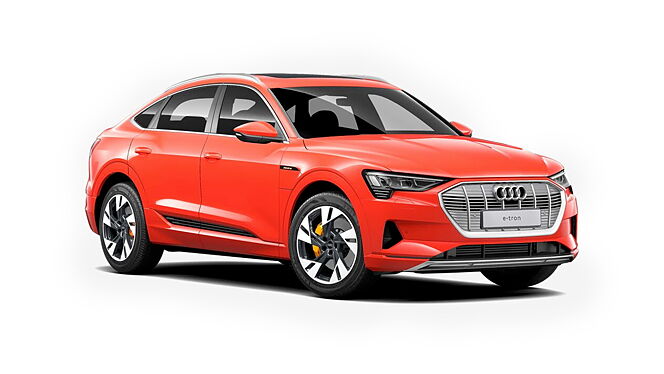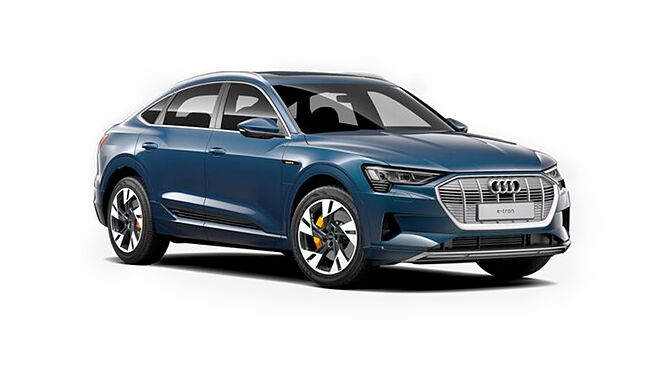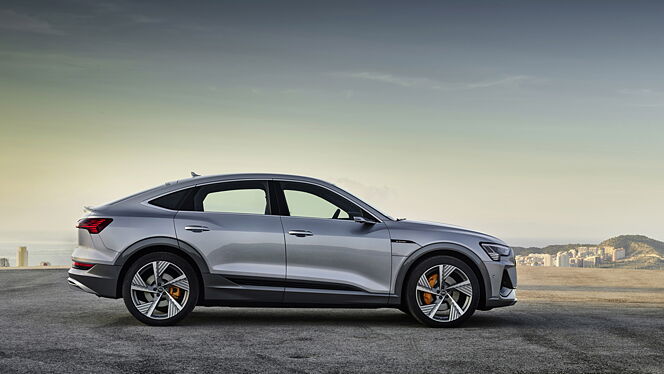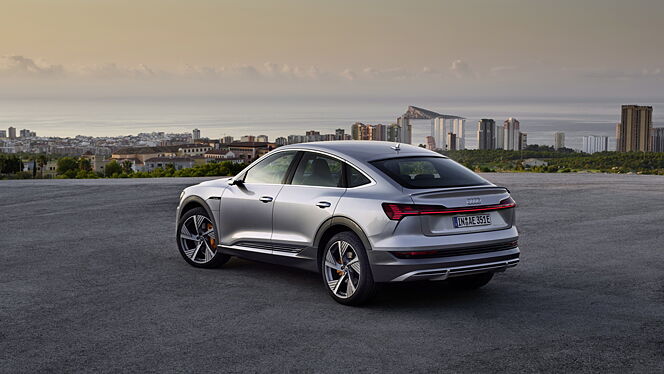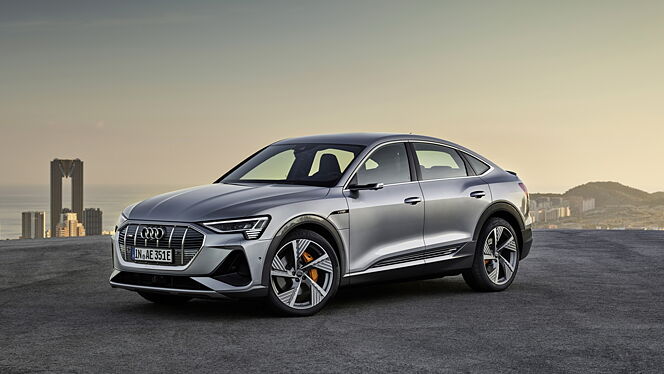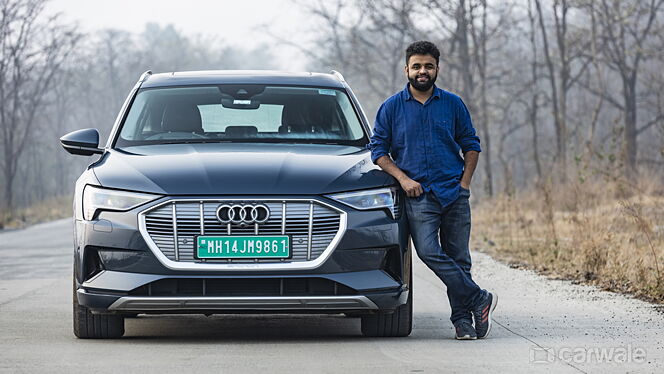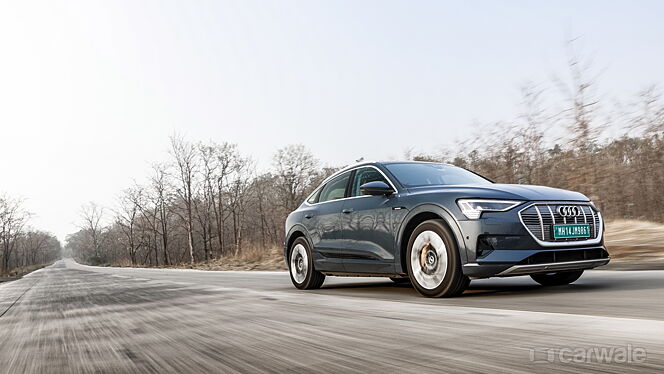Audi e-tron Sportback 55
- e-tron Sportback
- Offers
- Specs & Features
- Variants
- Colours
Variant
Calculate your EMI
EMI Calculator
Audi e-tron Sportback 55 Summary
Audi e-tron Sportback 55 Review
8
Summary
8

You know how nearly all luxury carmakers have sleeker, couple-like versions of their SUV models? That trend is going pretty strong, so much so that it has now been stretched beyond traditional petrol and diesel SUVs to include EVs like the Audi e-tron Sportback. It’s a win-win situation because it gives Audi access to buyers in two slightly different demographics at not so very different price points. The relatively low-slung e-tron Sportback, for instance, costs just Rs 2 lakh over the standard e-tron and in return gets you styling that’s more akin to an exotic car. What about the rest though? Is it just as impressive as the regular e-tron? Let’s find out.
Engine and Performance
7.5

Engine? There’s no such thing here. The e-tron Sportback’s lifeblood comes in the form of a 95kWh battery that’s mounted beneath the passenger shell. It feeds two electric motors (one per axle) which jointly deliver up to 300kw of power that translates to 408bhp/664Nm. Now, logic dictates that Audi would have been better off using a single large motor but this dual-motor setup not only helps achieve a better weight distribution but more importantly, allows the brand to facilitate its quattro all-wheel drive system into this electric SUV. Under normal conditions, the e-tron uses its rear electric motor to drive itself and it’s only when the driver’s right foot demands more power than it can supply, the all-wheel drive redistributes torque to the front axle.

The e-tron Sportback has a theoretical range of over 400km on a full charge. Of course that depends on several factors such as driving style and traffic conditions. According to Audi, the car’s regeneration system accounts for up to 30 per cent of the total range. Basically, every time the driver hits the brakes or gets off the accelerator, the e-tron regenerates power back into the battery. In both cases, the electric motors function as a generator and convert the kinetic energy of the e-tron into electric energy to leverage more charge into the battery. What’s interesting here is that the driver can adjust the extent of re-gen using the paddle shifters on the steering wheel. In the highest re-gen setting, the e-tron will decelerate and come to a stop rapidly as soon as you get off the accelerator. Ideally, then, one can drive the e-tron in traffic using just the accelerator pedal which is a little bizarre. In our range test which included driving the car under varied traffic conditions across Navi Mumbai and on the Mumbai Pune expressway, we were able to cover 370km with the battery percentage coming down to 7 per cent from a full charge. So it is possible for users to comfortably achieve 380km of range on a full charge and that’s not bad at all.

As for the EV driving experience, you begin by pushing the start/stop button and that’s it. No engine to crank nothing. It takes some getting used to the fact that there is zero noise and vibration before you slot the gear lever in Drive and set off. This is also where the fun part begins because in typical EV fashion, the e-tron reacts like a resolute athlete as soon as you push the throttle pedal, accelerating strongly compared to all other vehicles around you. With over 400bhp and 664Nm of instantaneous torque under your right foot, the e-tron is rapid and is easily capable of pinning you back in your seat under full-bore acceleration. Speaking of which, we managed to strap our timing gear and the results were quite impressive. 0-60kmph takes just 2.88 seconds and you will need all of 5.35 seconds to hit 100kmph from standstill. The e-tron Sportback is phenomenally quick in-gear, too, taking just 3.53 seconds for the 40-100kmph run.
Ride and Handling
7

The e-tron Sportback’s start-up and get-go process might be alien to some but there is nothing outlandish about the way this electric SUV rides and handles. Dynamically the e-tron feels quintessential Audi – everything from the steering feel to the body control is akin to that of a Q7. Sure, it cannot shift its mass around quite as fluidly as other full-size SUVs but for everyday driving, it’s not bad at all. This is largely down to the e-tron’s adaptive air suspension which does a great job of delivering an appropriately cushy ride in Comfort and safe, planted handling in Dynamic.

Now because this is a Sportback, a term that Audi has coined for their four-door coupe body style, the e-tron has a lower drag coefficient (0.25cd) compared to the standard model’s 0.27cd and that’s largely because of the downward sloping roofline. This has also resulted in a slightly lower centre of gravity although there is no real world difference in handling and body control. The adaptive suspension also allows the driver to raise the ride height on the move. This not only reduces the chances of underbody scraping but more crucially, also keeps the battery pack safe. As for the ride quality, the e-tron is just like any petrol/diesel luxury SUV when it comes to smothering the harshness in bumps and pot holes. There is no underlying stiffness to its ride and for something that weighs over 2.5 tonne, there isn’t much side to side movement over undulations either.
Interior Space and Comfort
8

Like all flagship Audi models, the interior look and appeal is headlined by the two large touchscreen displays - one for the infotainment system and the lower secondary unit houses the climate controls. Admittedly, the screens look brilliant, especially at night, but they are also big-time fingerprint magnets. The rest of the cabin is typically Audi which means everything you touch or operate has a quality feel to it, right down to the wiper/indicator stalks and controls for the wing mirrors. The e-tron Sportback sits between the Q5 and the Q7 so it’s not like you are going to feel short-changed for space.

The car’s dimensions, in fact, are quite large which translates to an airy, comfortable cabin. The front seats are big and supportive and because the e-tron is so wide, the seats are set at a good distance apart. Again, legroom and shoulder room at the back are plentiful and the rear bench is also equally supportive with good cushioning all around. What’s not so good is the obvious flaw that comes with any car with a heavily sloped roofline at the back and that’s headroom. Despite the scooped-out roof lining, it might get a little claustrophobic for tall occupants but in the overall scheme of things, the Sportback’s rear seat accommodation isn’t a deal breaker in any way. The other tradeoff for having a steeply raked rear glass is the reduced amount of boot space and in this case, the boot capacity has come down to 616 litres from the standard e-tron’s 660 litres.

Features and Equipment
8

The India-spec e-tron range gets panoramic sunroof, Matrix LED headlamps, soft-closing doors, Audi’s virtual cockpit (digital instrument cluster), ambient lighting, wireless charging, 16-speaker Bang and Olufsen sound system, four-zone climate control and a heads-up display. In some markets the e-tron also gets virtual mirrors which are basically cameras instead of door mirrors projecting the visuals across dedicated screens on the front doors. The e-tron also comes with an optional 22kW AC charger though what’s really handy is that Audi has put charging points on both sides of the e-tron.

There’s an AC/DC port on the driver’s side and an AC port on the other side to make charging that much easier when you simply want to plug it either way to your household AC provision. When connected to the compact mobile charging system that comes standard with the car, the battery can be charged to 80 per cent in four and a half hours. Meanwhile, an 11kW AC home charger can fully charge the e-tron in eight and a half hours.
Conclusion
8

The e-tron Sportback makes for a convincing buy, whether you are looking for a luxury SUV with some flair or a straight-up electric vehicle. It’s quicker than most SUVs in its class and it feels and drives like a conventional luxury vehicle which is probably the most impressive thing about it. Add in the comfortable road manners, solid build quality and a real world range of over 350kms and it makes for a compelling electric car to live with. This Sportback version costs just Rs 2 lakh more than the standard e-tron and makes a stronger case for itself but only if you are willing to sacrifice a bit of headroom and boot space for the added flair and road presence.
Pictures by Kapil Angane
e-tron Sportback 55 Specifications & Features
- Specifications
- Features
- Specifications
- Features
Specifications
Engine & Transmission
- Top Speed200 kmph
- Acceleration (0-100 kmph)5.7 seconds
Time the car takes to reach 100kmph from a standstill
- EngineNot Applicable Cylinders Not Applicable, Not Applicable Valves/Cylinder, Not Applicable
Timely services will keep a motor efficient and in top shape.
- Engine TypeDual Asynchronous Motors
The official title given by the manufacturer in terms of the name of the engine, the displacement and the number of cylinders.
A bigger displacement and more than four-cylinders generally indicate a performance-oriented engine.
- Fuel TypeElectric
All cars in India either run on petrol, diesel, CNG, LPG or electric power.
- Max Motor Performance402 bhp, 664 Nm
The time it takes for the electric motor equipped car to reach higher speeds from a standstill
- Driving Range484 km
Approximate maximum number of kilometers which can be traveled on a full tank of fuel or fully charged battery
- DrivetrainAWD
Cars come with different drivetrain configurations depending on the segment.
Front-wheel drive (FWD) is most common in mainstream cars while expensive cars or SUVs come with rear-wheel drive (RWD) or all-wheel drive (AWD).
- TransmissionAutomatic - 1 Gears, Sport Mode
Type of transmission used to transfer power from the engine to the wheels
A manually operated transmission is the most popular type, thanks to its simplicity and low cost. Varied types of automatic transmissions are also available.
- Battery95 kWh, Lithium Ion,Battery Placed Under Floor Pan
Keeping the battery terminals free of corrosion prevents starting trouble
- Electric Motor2 3 Phase AC Induction Motor Placed At One motor each on front and rear axle
Tests reveal that electric cars are substantially more efficient than internal combustion engines.
- OthersPure Electric Driving Mode
Dimensions & Weight
- Length5014 mm
The length of the car decides its segment. In India, cars that are less than 4 metres in length enjoy reduced excise duties.
- Length: 5014
Longer length results in more cabin space. It also adds to straight line stability.
- Width1976 mm
A car's width is defined as its widest point without its mirrors.
- Width: 1976
Although more width gives you more lateral space inside the cabin, it makes the car more difficult to park in narrow spots.
- Height1686 mm
The height of the car denotes the highest point of the vehicle from the ground.
- Height: 1686
Taller the car, the more headroom there is on offer inside the cabin. However, a tall boy stance also affect the car’s centre of gravity which can cause more body roll.
- Wheelbase2928 mm
The space between the center of the front and rear wheels.
- Wheelbase: 2928
The longer the wheelbase, the more space there is inside the cabin.
- Kerb Weight2595 kg
The total weight of the vehicle with all the standard equipment and all the required fluids.
A lightweight car will always be more efficient and easier to manoeuvre whereas a heavy car would give you a sense of solidity while driving.
Capacity
- Doors5 Doors
The number of doors define the category of car. For example – four door means sedan, two-door means coupe while five-doors usually refer to a hatchback, MPV or an SUV.
- Doors: 5
- Seating Capacity5 Person
The number of people that can be seated comfortably in the car, which has also been mandated by the car manufacturer.
- No of Rows2 Rows
Smaller cars usually have two rows which can seat five, but some SUVs and MPVs have three rows and can seat around 7-8 passengers.
- Bootspace615 litres
Boot space defines how practical the car is with respect to how much luggage it can carry.
- Bootspace: 615
A boot with a large and wide opening is ideal for loading heavy items. Additionally, a lower loading height also makes it easy to put in luggage.
Suspensions, Brakes, Steering & Tyres
- Front Suspension5-link Axle, Tubular Anti-roll Bar, Air Suspension
Almost all cars in India use an independent front suspension which is usually the MacPherson Strut type.
- Rear Suspension5-link Axle, Tubular Anti-roll Bar, Air Suspension
The rear suspension can either be non-independent or independent.
Most of the budget cars have non-independent suspension while the more expensive ones get independent rear suspension which offers better bump absorption.
- Front Brake TypeDisc
Most of the vehicles sold in India get ventilated or non-ventilated disc brakes upfront.
- The ventilated discs are more popular thanks to them providing better stopping power and it also works well in hot conditions.
- Rear Brake TypeDisc
In affordable cars, drums brakes are fitted at the rear as they are cost effective.
Disc setup at the rear is now getting more popular as cars are getting faster in the real world.
- Minimum Turning Radius6.1 metres
The official kerb-to-kerb minimum radius a car takes to complete a 180-degree turn.
Shorter the turning radius, the lesser space you need to make a tight turn or to take a U-turn.
- Steering TypePower assisted (Electric)
Almost all steering systems in cars today have an assist to help park them better at low speeds - these can be hydraulic, electro-hydraulic or electric.
- WheelsAlloy Wheels
The wheels used on cars are either steel rims with plastic wheel cover hub or alloy wheels on higher spec models or expensive cars.
Razor cut, or diamond cut alloy wheel design are not getting more popular. Manufacturers usually offer these in top-end trim of their car models.
- Spare WheelSpace Saver
Important in a country with varying quality of roads, spare wheels ensure one doesn’t get stranded when one of the main tyres gets damaged.
Select premium car models feature space savers (smaller than the stock wheels) to save on boot space.
- Front Tyres255 / 50 R20
The profile/dimension of rubber tyre that fits on the front wheels.
- Rear Tyres255 / 50 R20
The profile/dimension of rubber tyre that fits on the rear wheels.
Features
Safety
- Overspeed Warning1 beep over 80kmph, Continuous beeps over 120kmph
Mandatory safety system for cars sold in India, a single beep is emitted after 80kmph and continuous ones after 120kmph
- Lane Departure WarningNo
This function detects when the car is drifting out of its lane and cautions the driver through audio/visual alerts
- Emergency Brake Light FlashingYes
The brake lights flash in a quick intermittent fashion to indicate to the following vehicles to slow down quicker than usual
- Forward Collision Warning (FCW)Optional
The driver is warned of an impending crash due to stopped/slowing vehicles ahead of them
- Automatic Emergency Braking (AEB)Optional
This system automatically stops the car if it senses an obstacle where the driver fails to take action
It is imperative to pay attention while driving and rely less on such systems
- High-beam AssistOptional
This feature spots oncoming vehicles at night to shift the headlight between high and low beam
- NCAP Rating5 Star (Euro NCAP)
The official crash test safety rating given to a car by one of the many testing agencies around the world
- Blind Spot DetectionNo
Blind Spot Detection systems use sensors to detect and alert the driver of any sudden movements in his/her blind spot
- Lane Departure PreventionNo
This feature automatically steers the car to prevent it from moving out of the lane when there is no driver input
- Rear Cross-traffic AssistNo
An assistance feature that alerts the driver who is backing out of a parking space if another vehicle is approaching
One must always be cautious of pedestrians, children and other obstacles when backing up.
- Airbags8 Airbags (Driver, Front Passenger, 2 Curtain, Driver Side, Front Passenger Side, 2 Rear Passenger Side)
- Rear Middle Three Point seatbeltYes
Safer three-point seatbelts for passengers seated in the middle of the second row of seats.
Budget cars are usually fitted with more economical lap belts for the middle-occupant.
- Rear Middle Head RestYes
A headrest for the middle occupant of the second-row of seats.
Budget cars are usually not offered with headrests for the middle occupant of the second-row to save on costs. Headrests are instrumental in reducing whiplash injuries in case of an accident
- Tyre Pressure Monitoring System (TPMS)Yes
A digital gauge that provides the live status of the air pressure in every tyre of a car.
For accurate readings, ensure that the sensors on the rim are not tampered with during any wheel/tyre repairs
- Child Seat Anchor PointsYes
Anchor points or strap systems built into car seats to keep child seats in place, especially during a crash
ISOFIX is an international standard for child seat anchor points, but not all car manufacturers follow this standard
- Seat Belt WarningYes
Mandatory fitment in cars sold in India, emits loud beeps when it detects that occupants are not wearing their seatbelts.
Seat belt warning is mandatory for front-seat occupants, but it is recommended that all occupants wear seat belts.
Braking & Traction
- Anti-Lock Braking System (ABS)Yes
An electronic system that prevents the tyres from locking and skidding in emergency braking situations by pulsing the brakes (quickly releasing and reapplying the brakes)
ABS is a great accident prevention technology, allowing drivers to steer while braking hard
- Electronic Brake-force Distribution (EBD)Yes
An electronic system that redirects braking forces among the four brakes to stop the car as quickly and stably as possible
- Brake Assist (BA)Yes
A system that increases brake pressure to help the car stop quicker
Even when emergency braking, it is observed that drivers don’t apply maximum brake pressure through the pedal, the BA system provides additional pressure to help stop the car quicker
- Electronic Stability Program (ESP)Yes
System designed to improve car stability and control, especially when the car is accelerating.
ESP or ESC cannot increase traction but rather improve control or help regain control in slippery conditions.
- Four-Wheel-DriveTorque-On-Demand
A system that sends the car's power to all the four wheels at the same time
- Hill Hold ControlYes
A feature that prevents the car from rolling backwards when stopped on a slope
- Traction Control System (TC/TCS)Yes
This system cuts power to those wheels that are spinning without grip/traction
Given the option, keep traction control on all the time.
- Ride Height AdjustmentYes
A feature that allows the user to alter the ride height of the car
Be it driving over tall obstacles or unloading heavy baggage from the boot; a helpful feature indeed
- Hill Descent ControlNo
A feature that limits the car's speed without any driver input while traversing down descents
- Limited Slip Differential (LSD)No
This function prevents wheelspin and maximises traction by shuffling torque between wheels
It is also a nifty safety feature since it offers more control over a vehicle's power delivery
- Differential LockNo
Locking differentials split power/torque evenly among both tyres on an axle.
In off-road vehicles, locking differentials allows for better traction when one of the wheels is in the air, in FWD/AWD cars allows for better corner traction and in RWD sports cars allows for drifting around corners.
Locks & Security
- Engine ImmobiliserNo
A security device that prevents the engine from being started unless the key is present
- Central LockingYes
This feature let's one unlock all the doors remotely or with a key
- Speed Sensing Door LockYes
This feature automatically locks the car's doors when it reaches a preset speed
A convenient feature for those who can't remember to lock the doors
- Child Safety LockYes
Such locks are built into the rear doors to prevent rear seat occupants from opening the doors
Comfort & Convenience
- Electronic Parking BrakeYes with Auto Hold
- Air ConditionerYes (Automatic Four Zone)
The different types of air-conditioning systems used to cool the cabin
Maintaining the lowest temperature and first blower speed offers the best results.
- Front ACTwo Zones, Individual Fan Speed Controls
- Rear ACTwo Zones, Vents Behind Front Armrest and on Pillars, Individual Fan Speed Controls
- HeaterYes
This feature allows warm air to pass through the air-con vents for heating the cabin
- Vanity Mirrors on Sun VisorsDriver & Co-Driver
Compact mirrors fitted to the inside of the sunvisor
- Cabin Boot AccessYes
The option of being able to access the boot space while sitting inside the car
- Anti-glare MirrorsElectronic - All
These mirrors negate the glare from headlight beams of cars behind you
Since a large chunk of people love driving around in their high beam, these mirrors come in handy
- Parking AssistReverse Camera with Guidance
A feature that aids drivers park with ease and greater precision using sensors/cameras
It comes as a boon for drivers who are not used to parking in tight spots
- Parking SensorsFront & Rear
Sensors that are usually located on the bumpers of a car to assist/alert the driver while parking
It takes the stress out of manoeuvring in confined spaces
- Cruise ControlYes
A system that automatically controls the speed of the car
- Headlight and Ignition On ReminderYes
An alert that warns one from leaving the car with the headlight and ignition switched on
- Keyless Start/ Button StartYes
When fitted, this system allows the car to be switched on without removing the key from the driver’s pocket or vicinity.
Keyless entry and start/stop (KESS) systems in some cars also include operation via a smartphone.
- Steering AdjustmentTilt & Telescopic
A function where the steering wheel moves up/down, in/out as per the driver's requirement
When both rake and reach adjustments are incorporated, it makes for a tailormade driving position
- 12V Power Outlets2
This socket provides current to a cigarette lighter style 12 volt plug
It helps charge smartphones, tablets, laptops, rechargeable batteries and other USB chargers. It also powers a compressor that inflates tyres and the humble cigarette lighter!
Mobile App Features
- Find My CarYes
An app based feature that allows one to find where their car is located/parked
- Check Vehicle Status via AppYes
The requisite app will provide information regarding various functions such as speed and fuel alerts
- Geo-fenceYes
A service that triggers actions like notifications and security alerts when a car enters/leaves a set location
- Emergency CallYes
A call that's made automatically by the car to the local emergency services in the event of a crash
- Over The Air (OTA) UpdatesYes
Similar to how smartphones receive updates, a vehicle too (if equipped with connected car features) receives updates over the air via a cellular or WiFi connection
Timely installation of updates keeps the system up-to-date
- Remote AC: On / Off via AppYes
The smartphone app turns on the car's AC to attain the required cabin temperature even before one boards it
More so comes in handy when cabin temperatures are extreme before you board the vehicle
- Remote Car Lock/Unlock via AppYes
The smartphone app allows one to remotely lock/unlock the car's doors from just about anywhere
This function is helpful when the key fob isn't working properly
- Car Light Flashing & Honking via AppYes
The smartphone app sounds the horn and flashes the headlights of your car so that you can locate it
Seats & Upholstery
- Driver Seat Adjustment12 way electrically adjustable with 2 memory presets (seat forward / back, backrest tilt forward / back, seat height up / down, lumbar up / down, lumbar forward / back, seat base angle up / down) + 2 way manually adjustable (headrest up / down)
- Front Passenger Seat Adjustment12 way electrically adjustable with 2 memory presets (seat forward / back, backrest tilt forward / back, seat height up / down, lumbar up / down, lumbar forward / back, seat base angle up / down) + 2 way manually adjustable (headrest up / down)
- Rear Row Seat Adjustment2 way manually adjustable (headrest up / down)
Rear seat adjustments make for an enlarged luggage space when there's lots of baggage to haul.
- Seat UpholsteryLeather
When it's time to replace, use a fabric that grips and are inherently cool to the touch
- Leather-wrapped Steering WheelYes
Leather not only grips your palms well, but it also offers a premium feel
- Leather-wrapped Gear KnobYes
- Driver ArmrestYes
The armrest located between the front passengers which helps comfort the driver's arm while driving
- Rear Passenger Seat TypeBench
- Ventilated SeatsNo
Cooled air from the AC system passes through the perforations on the seat to comfort the occupant
- Ventilated Seat TypeNo
- InteriorsDual Tone
Depicts if the cabin comes with a single or dual-tone colour scheme
- Interior ColoursBlack, Okapi Brown and Mother of Pearl Beige
The various color shades used within the cabin
- Rear ArmrestYes
- Folding Rear SeatFull
Some rear seats have the option to be be folded to offer more practicality
- Split Rear Seat40:20:40 split
Sections of the rear seat are capable of being folded down separately
This function bumps up practicality as the boot space increases when required.
- Front Seatback PocketsYes
The pockets behind the front seats which help rear seat occupants store their stuff
- HeadrestsFront & Rear
The portion extending from or fixed to the seat that supports the head
Storage
- Cup HoldersFront Only
- Driver Armrest StorageYes
The storage space within the armrest that's located between the front passengers
- Cooled GloveboxNo
A feature where cool air from the air-conditioner is diverted to the glovebox
- Sunglass HolderNo
Doors, Windows, Mirrors & Wipers
- ORVM ColourBody Coloured
Mirrors that are placed on the car's exterior, around the door, to aid the driver see behind the vehicle
Placing/sticking wide-angle mirrors on the ORVMs can enhance the rear view tremendously.
- Scuff PlatesAluminium
This is fitted where the door meets the frame to protect it from scratches and dust
Not using scuff plates may result in the door sill giving away prematurely.
- Soft-close DoorOptional
- Power WindowsFront & Rear
When the car's windows can be raised/lowered by pressing a button/switch
In emergencies where the power window electronics have jammed, exit the vehicle by kicking out the windscreen
- One Touch DownAll
This feature allows a user to roll down the windows with a single press of a button
This feature reduces the time your hand is away from the steering wheel
- One Touch UpAll
This feature allows a user to roll up the windows with a single press of a button
This feature reduces the time your hand is away from the steering wheel
- Adjustable ORVMsElectrically Adjustable & Retractable
Different ways of adjusting the door mirror to suit the driver's requirement
Tremendously aids driving judgement in a variety of tight situations.
- Turn Indicators on ORVMsYes
Turn indicators are fitted to the door mirrors for improved visibility
- Rear DefoggerYes
A feature that removes condensed water droplets from the rear windscreen to improve visibility
Turning air recirculation off helps gain faster results.
- Rear WiperYes
Although a seemingly minuscule feature, it negates the hatchback's/SUV's inherent ability to retain dirt/water on the rear windscreen.
- Exterior Door HandlesBody Coloured
- Rain-sensing WipersYes
When the system detects water droplets on the windshield, it activates the wipers to improve driver visibility
This feature can be intrusive especially while you are negotiating a tricky bend at a higher speed
- Interior Door HandlesSilver
- Door PocketsFront & Rear
- Bootlid OpenerFoot Trigger Opening/Automatic
The various methods of opening the boot lid
Exterior
- Sunroof / MoonroofPanoramic Sunroof
Ensure the sunroof is closed before exiting the vehicle to prevent dirt/rain from entering the cabin
- Roof-mounted AntennaYes
The compactness of the roof-mounted antenna prevents its damage in certain situations
- Body-coloured BumpersYes
Having parking sensors will save your bumper paint if it brushes by obstacles
- Chrome Finish Exhaust PipeNo
- Body KitCladding - Black/Grey
Functional or purely aesthetic parts added to the car's body such as side skirts and roof/bonnet scoops
- Rub-stripsBlack
A strip of rubber fitted to the sides of the car's doors or bumpers to prevent dents and dings
Opt for quality strips because the cheaper ones tend to come off too soon/look shabby.
Lighting
- Ambient Interior Count30
- HeadlightsLED
- Automatic HeadlampsYes
Such headlights automatically switch on and off when they sense bright or dark driving conditions
Keeping them switched on at all times gives the user the best results
- Follow Me Home HeadlampsYes
The headlamps remain lit for sometime when the car is locked/unlocked to aid user visibility in dark surroundings
- Cornering HeadlightsIntelligent
These lights turn left and right based on steering inputs to illuminate the sides of the car
- TaillightsLED
Inspect tail lamp bulbs at periodic intervals for optimum safety.
- Daytime Running LightsLED
Lights that automatically switch on during the day for increased visibility
- Fog Lights-
A type of lamp that improves driver visibility while driving through fog
The yellow/amber fog lights are preferable as they are warm to the eyes and do not reflect from the fog.
- Ambient Interior LightingMulti-colour
Additional lighting apart from the roof-mounted courtesy/map lamps. These are added for a sense of style and luxury rather than utility.
- Puddle LampsYes
Incorporated into the bottom section of a car's door mirrors, they light up the ground underneath the front door when the door is unlocked
- Cabin LampsFront and Rear
- Light on Vanity MirrorsDriver & Co-Driver
A lamp that's located around the vanity mirror behind the sun visor
- Rear Reading LampYes
- Glovebox LampYes
- Headlight Height AdjusterYes
Allows adjustment to the height of the headlight beams via a switch on the dashboard
Instrumentation
- Instantaneous ConsumptionYes
It indicates how much fuel is being used that very instant your car is moving
- Instrument ClusterDigital
A screen situated mostly behind the steering wheel displaying information and warning lights regarding the car's various vitals
- Trip MeterElectronic 2 Trips
- Average Fuel ConsumptionYes
The amount of fuel consumed by the engine (kmpl) is displayed on the instrument cluster in real time
A glance will help you maintain better fuel efficiency and save money
- Average SpeedYes
The total distance traveled divided by the time taken to cover that distance
The higher the average speed, the quicker you were on that journey/trip
- Distance to EmptyYes
The approximate distance a car will run with the amount of fuel remaining in the tank
- ClockDigital
- Low Fuel Level WarningYes
This alert should be taken as a final warning to head straight to the fuel pump
- Door Ajar WarningYes
A warning light that pops up on the instrument cluster when the doors are not shut properly
- Adjustable Cluster BrightnessYes
The brightness of the instrument cluster can be adjusted via controls
It comes in handy to improve instrumentation visibility between day and night by toggling brightness.
- Gear IndicatorNo
It notifies the driver about which gear the car is being driven in and can also suggest down- or upshifting to improve efficiency
- Shift IndicatorNot Applicable
Notifies the driver about the optimum instances to shift gears
It comes in handy to derive the best fuel efficiency and engine component longevity
- Heads Up Display (HUD)Optional
This function allows specific data like 'speed' to reflect/project on the windscreen in the driver's line-of-sight
- TachometerNo
An instrument that measures engine speed in revolutions-per-minute (rpm)
Ideally, the tachometer helps a driver know when to shift gears in a manual gearbox.
Entertainment, Information & Communication
- Android AutoYes
An Android feature that allows car infotainment displays to mirror parts of the phone screen to ease touch operations while driving.
- Apple CarPlayYes
An Apple (iOS) feature that allows car infotainment displays to mirror parts of the iPhone screen to ease touch operations while driving.
This function bumps up the safety quotient since the use of a smartphone while driving can be hazardous
- DisplayTouch-screen Display
A touchscreen or display that acts as a user's interface to the various functions of the car
- Touchscreen Size10.1 inch
- Integrated (in-dash) Music SystemYes
The music player that comes factory fitted
- Speakers6+
Number of speaker units as part of a car’s surround-sound system
- Steering-mounted controlsYes
The widely-used controls are placed on the steering wheel to ease driver usage
- Voice CommandYes
When the car's system responds to the occupant's voice to perform certain features
- GPS Navigation SystemYes
A system that uses satellite signals to help the driver with directions to reach a destination
- Bluetooth CompatibilityPhone & Audio Streaming
Allows devices with bluetooth functionality connect wirelessly to the car's infotainment system
Using Bluetooth functionality offers a cable-free experience
- AUX CompatibilityYes
The car's music player can play tracks off a portable device via an aux cable
Bluetooth can make AUX cables look ancient, but unlike the former, there's hardly any loss in sound quality
- AM/FM RadioYes
Is the music system's capability of playing broadcasted radio channels
If radio signals are weak, one can stream music
- USB CompatibilityYes
When tracks can be played from a USB/pen drive
- Wireless ChargerYes
These pads can charge equipped smartphones without using a cable
Given the option, opt for fast wireless charging.
- Head Unit SizeNot Available
The size of the music system fitted to a car. Traditionally 1-DIN or 2-DIN, are being replaced by touchscreen units of varying sizes.
- iPod CompatibilityYes
Manufacturer Warranty
- Battery Warranty (In Years)8
The number of years the EV battery is covered under the manufacturer's warranty
More the years, the better
- Battery Warranty (In Kilometres)160000
The number of kilometres the EV battery is covered under the manufacturer's warranty
More the kilometres, the better
- Warranty (In Years)2
The automaker can void the vehicle's warranty if the owner has fitted aftermarket components.
- Warranty (In Kilometres)-
The automaker can void the vehicle's warranty if the owner has fitted aftermarket components.
Other e-tron Sportback Variants
| Variants | Price | Specifications | |
|---|---|---|---|
Rs. 1.26 Crore | 95 kWh, 484 km, Electric, Automatic | Get Offers from Dealers | |
Rs. 1.20 Crore | 5 Person, AWD, 2595 kg, 615 litres, 1 Gears, Dual Asynchronous Motors, Panoramic Sunroof, 484 km, No, Front & Rear, 5.7 seconds, 200 kmph, 95 kWh, 5 Star (Euro NCAP), 5014 mm, 1976 mm, 1686 mm, 2928 mm, Yes, Yes (Automatic Four Zone), Front & Rear, 1, Reverse Camera with Guidance, Yes, Yes, Yes, Yes, Torque-On-Demand, 8 Airbags (Driver, Front Passenger, 2 Curtain, Driver Side, Front Passenger Side, 2 Rear Passenger Side), Yes, 1, Not Applicable, 5 Doors, Electric, Automatic | Get Offers from Dealers |
e-tron Sportback Alternatives
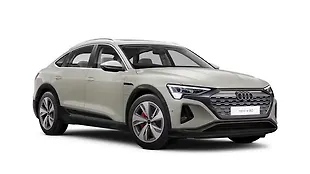
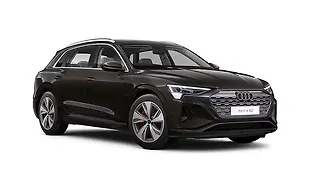
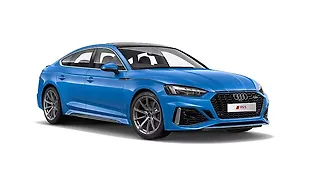


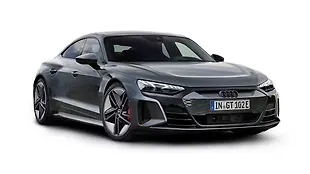
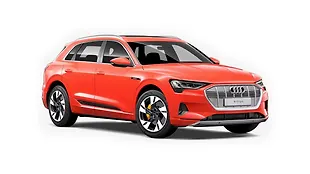
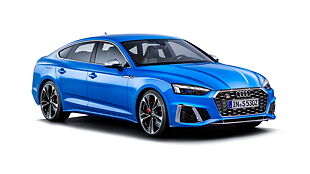
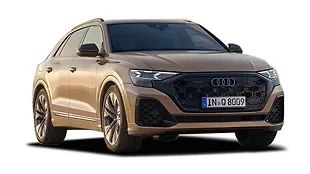
e-tron Sportback 55 FAQs
Get in touch with Authorized Audi Dealership on call for best buying options like:
Doorstep Demo
Offers & Discounts
Lowest EMI
Exchange Benefits
Get The Best Deal



